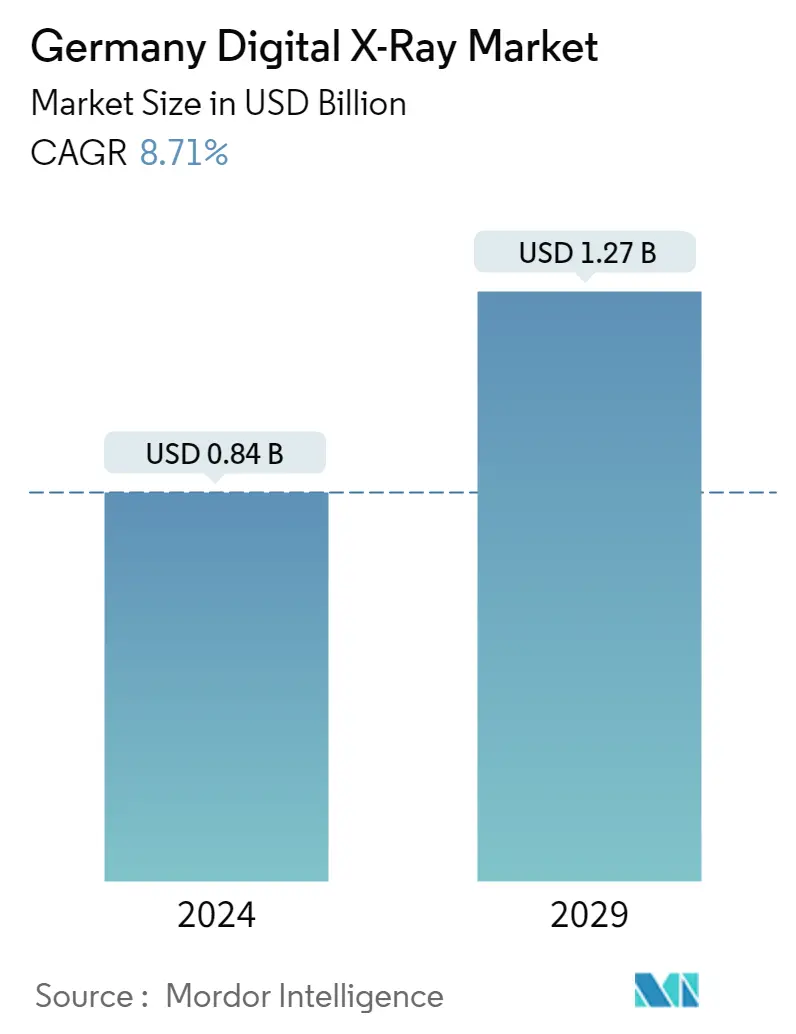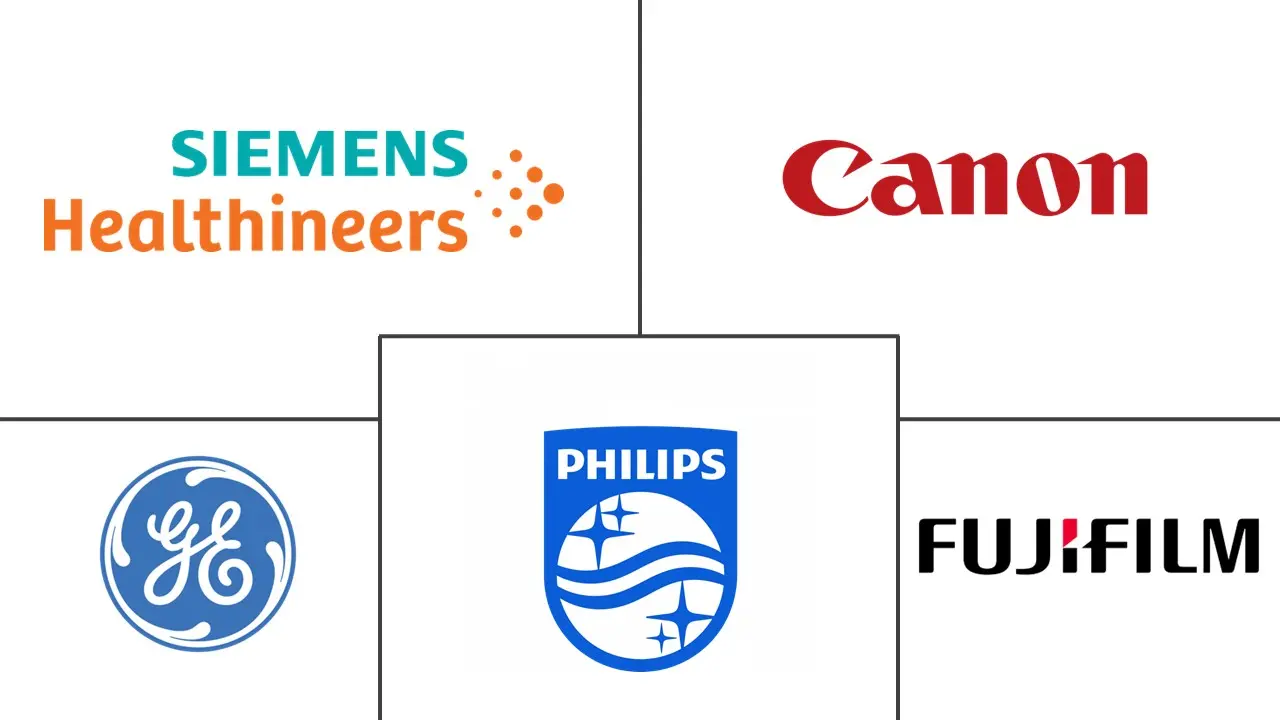Market Size of Germany Digital X-Ray Industry

| Study Period | 2019 - 2029 |
| Base Year For Estimation | 2023 |
| Market Size (2024) | USD 0.84 Billion |
| Market Size (2029) | USD 1.27 Billion |
| CAGR (2024 - 2029) | 8.71 % |
| Market Concentration | Medium |
Major Players
*Disclaimer: Major Players sorted in no particular order |
Germany Digital X-Ray Market Analysis
The Germany Digital X-Ray Market size is estimated at USD 0.84 billion in 2024, and is expected to reach USD 1.27 billion by 2029, growing at a CAGR of 8.71% during the forecast period (2024-2029).
The COVID pandemic had an adverse effect on the digital x-ray market growth. As seen by the significant drops in cancer screening rates in Germany during the early stages of the COVID-19 pandemic, screening and early detection scans were considered essential. According to a study published in May 2021 titled "New Cases of Cancer in the German State of Saxony's Clinical Cancer Registries that Have Been Documented When COVID-19 was widespread, "The anticipated and actual reports of new cancer cases significantly decreased during the lockdown period that started in March 2020. This finally had an impact on the overall scan count for diagnosis. Since digital x-ray scans are a vital diagnostic tool that can assist physicians in identifying or screening a variety of malignant and noncancerous tumors, the demand for digital x-ray machines was severely harmed. This has caused a large backlog in the diagnostic services offered in the nation, which has had a negative influence on the market for digital x-ray devices. Thus, in the upcoming future, the market is expected to grow.
The growing incidence of various diseases in the country, along with the increasing research on digital x-ray imaging, by public and private organizations, is boosting the segment growth in the country. German Heart Surgery Report 2020: The Annual Updated Registry of the German Society for Thoracic and Cardiovascular Surgery, published in June 2021 by the National Library of Medicine, reports that there were 843 assist device implantations (including left/right/biventricular assist devices, total artificial device), 29,444 isolated coronary artery bypass grafting procedures, 35,469 isolated heart valve procedures, and 35,469 isolated heart valve procedures registered in Germany. The same source also states that 340 isolated heart transplants were performed in Germany in 2019, an increase of 2.1% over the previous year. The demand for digital x-rays for disease diagnosis and treatment is thus anticipated to rise in the area due to the high prevalence of cardiovascular procedures.
In the market for digital x-ray devices, numerous events are happening in Germany, including new releases and approvals, partnerships, collaborations, mergers, and acquisitions. For instance, Agfa declared in March 2020 that the Buttstädt Surgery Practice in Germany now has a fully automated U-arm and floor-mounted DX-D 300 U-arm X-ray system. The DX-D 300 is perfect for imaging in an orthopedic surgery practice because of the extensive movement and rotation range of the digital detector, which permits a broad range of precise and complex exposures. Hence, the above developments are further expected to improve the market growth in the studied market.
Germany Digital X-Ray Industry Segmentation
As per the scope of this report, digital X-ray or digital radiography is a form of X-ray imaging where digital X-ray sensors are used instead of traditional photographic films. This has an added advantage of time efficiency and the ability to transfer images digitally and enhance them for better visibility. This method bypasses the chemical processing of photographic films. Digital X-ray imaging has high demand, as it requires less radiation exposure compared to traditional X-rays. German Digital X-Ray Market is Segmented by Application (Orthopedic, Cancer, Dental, Cardiovascular, and Other Applications), Technology (Computed Radiography, and Direct Radiography), Portability (Fixed Systems, and Portable Systems), and End User (Hospitals, Diagnostic Centers, and Other End Users). The report offers the value (in USD million) for the above segments.
| By Application | |
| Orthopedic | |
| Cancer | |
| Dental | |
| Cardiovascular | |
| Other Applications |
| By Technology | |
| Computed Radiography | |
| Direct Radiography |
| By Portability | |
| Fixed Systems | |
| Portable Systems |
| By End User | |
| Hospitals | |
| Diagnostic Centers | |
| Other End Users |
Germany Digital X-Ray Market Size Summary
The Germany digital x-ray market is poised for significant growth over the forecast period, driven by the increasing incidence of diseases and advancements in digital x-ray imaging technology. The market experienced a setback during the COVID-19 pandemic due to reduced cancer screening rates, which highlighted the critical role of digital x-ray scans in diagnosing both malignant and noncancerous tumors. This disruption led to a backlog in diagnostic services, but the demand for digital x-ray machines is expected to rebound as healthcare services normalize. The prevalence of cardiovascular procedures and the rising burden of cancer, particularly breast cancer, are key factors propelling the market forward. Strategic initiatives, including partnerships and technological innovations, are further enhancing the market landscape, with companies like Agfa and Vara leading advancements in digital x-ray systems and AI-driven diagnostic tools.
The competitive landscape of the Germany digital x-ray market is characterized by the presence of major players such as Canon Medical Systems, Siemens Healthineers AG, GE Healthcare, Fujifilm Holdings Corporation, and Koninklijke Philips NV. These companies are actively involved in mergers, acquisitions, and the development of next-generation digital x-ray systems to strengthen their market positions. For instance, Siemens Healthineers' acquisition of Varian aims to create a comprehensive portfolio for cancer diagnosis and treatment. Additionally, research and development efforts, such as those conducted by Friedrich Alexander University, are exploring innovative imaging techniques to enhance cancer detection. These developments, coupled with ongoing investments in new technologies, are expected to drive the market's growth, making digital x-ray devices an integral component of Germany's healthcare infrastructure.
Germany Digital X-Ray Market Size - Table of Contents
-
1. MARKET DYNAMICS
-
1.1 Market Overview
-
1.2 Market Drivers
-
1.2.1 Increasing Prevalence of Chronic Diseases
-
1.2.2 Increasing Technological Advancements
-
-
1.3 Market Restraints
-
1.3.1 High Cost of Equipment
-
-
1.4 Porter's Five Force Analysis
-
1.4.1 Threat of New Entrants
-
1.4.2 Bargaining Power of Buyers/Consumers
-
1.4.3 Bargaining Power of Suppliers
-
1.4.4 Threat of Substitute Products
-
1.4.5 Intensity of Competitive Rivalry
-
-
-
2. MARKET SEGMENTATION (Market Size by Value - USD million)
-
2.1 By Application
-
2.1.1 Orthopedic
-
2.1.2 Cancer
-
2.1.3 Dental
-
2.1.4 Cardiovascular
-
2.1.5 Other Applications
-
-
2.2 By Technology
-
2.2.1 Computed Radiography
-
2.2.2 Direct Radiography
-
-
2.3 By Portability
-
2.3.1 Fixed Systems
-
2.3.2 Portable Systems
-
-
2.4 By End User
-
2.4.1 Hospitals
-
2.4.2 Diagnostic Centers
-
2.4.3 Other End Users
-
-
Germany Digital X-Ray Market Size FAQs
How big is the Germany Digital X-Ray Market?
The Germany Digital X-Ray Market size is expected to reach USD 0.84 billion in 2024 and grow at a CAGR of 8.71% to reach USD 1.27 billion by 2029.
What is the current Germany Digital X-Ray Market size?
In 2024, the Germany Digital X-Ray Market size is expected to reach USD 0.84 billion.

